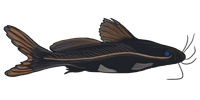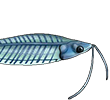Costa, W.J.E.M., Vilardo, P. and Katz, A. M. 2020. Sympatric sister species with divergent morphological features of psammophilic catfishes of the south-eastern Brazilian genus Microcambeva (Siluriformes: Trichomycteridae). Zoologischer Anzeiger. Available online 20 January 2020. In Press, Journal Pre-proof.
Abstract:
An undescribed species of Microcambeva, a genus of small psammophilic catfishes from the Atlantic Forest of south-eastern Brazil, was found together the congener M. ribeirae inhabiting the same sand stretch of a stream, in the Rio Ribeira do Iguape basin. The new species and its sympatric congener exhibit highly divergent morphological features, but a multigene phylogeny support them as sister taxa. The new species, M. filamentosa sp. nov., is readily distinguished from all other congeners by the presence of long barbels, long filamentous first pectoral-fin ray and a hypertrophied predorsal adipose fold. Microcambeva filamentosa and M. ribeirae share two unique apomorphic features: a single supraorbital pore s6 situated on the centre of the dorsal surface of the head and a deep concavity between the dorsal process of the opercle and the opercular odontode patch, conditions that are independently acquired in other psammophilic trichomycterids. A comparative context, involving other trichomycterid lineages exhibiting similar morphological adaptations, highly suggests that morphological differences between M. filamentosa and M. ribeirae are related to different strategies to exploit their habitat. In M. ribeirae, the short and thickened first pectoral-fin ray is interpreted as an adaptation to the fish posing propped on the substratum while visually detecting potential preys, what is reinforced by the unique possession in this taxon of a relatively large eye positioned on the top of the head. On the other hand, the relatively small eye and long barbels of M. filamentosa highly suggest the use of a predominantly chemosensory and tactile detection of food, indicating possible nocturnal habits.
https://www.sciencedirect.com/science/a ... via%3Dihub
Microcambeva filamentosa, new species (Trichomycteridae)
-
lfinley58
- Expert
- Posts: 725
- Joined: 04 Jan 2003, 19:16
- I've donated: $90.00!
- My articles: 3
- My images: 3
- Spotted: 3
- Location 1: Margate
- Location 2: Florida USA
- Interests: Catfishes (all), Aquarium History
-
Bas Pels
- Posts: 2918
- Joined: 21 Dec 2006, 20:35
- My images: 1
- My cats species list: 28 (i:0, k:0)
- Spotted: 8
- Location 1: the Netherlands
- Location 2: Nijmegen the Netherlands
- Interests: Central American and Uruguayan fishes
Re: Microcambeva filamentosa, new species (Trichomycteridae)
This could be a good example of evolution without a fysical barrier - that is, a species found, along with the known ecological niche, a new, free one and took advantage of this new opportunity, resulting in part of the old species developing into a new one.
Call it a speciesflock of 2, if you want.
Call it a speciesflock of 2, if you want.
cats have whiskers
-
lfinley58
- Expert
- Posts: 725
- Joined: 04 Jan 2003, 19:16
- I've donated: $90.00!
- My articles: 3
- My images: 3
- Spotted: 3
- Location 1: Margate
- Location 2: Florida USA
- Interests: Catfishes (all), Aquarium History
Re: Microcambeva filamentosa, new species (Trichomycteridae)
Hi Bas Pels,
A very interesting thought. I do like the mini-species flock approach.
Lee
A very interesting thought. I do like the mini-species flock approach.
Lee




